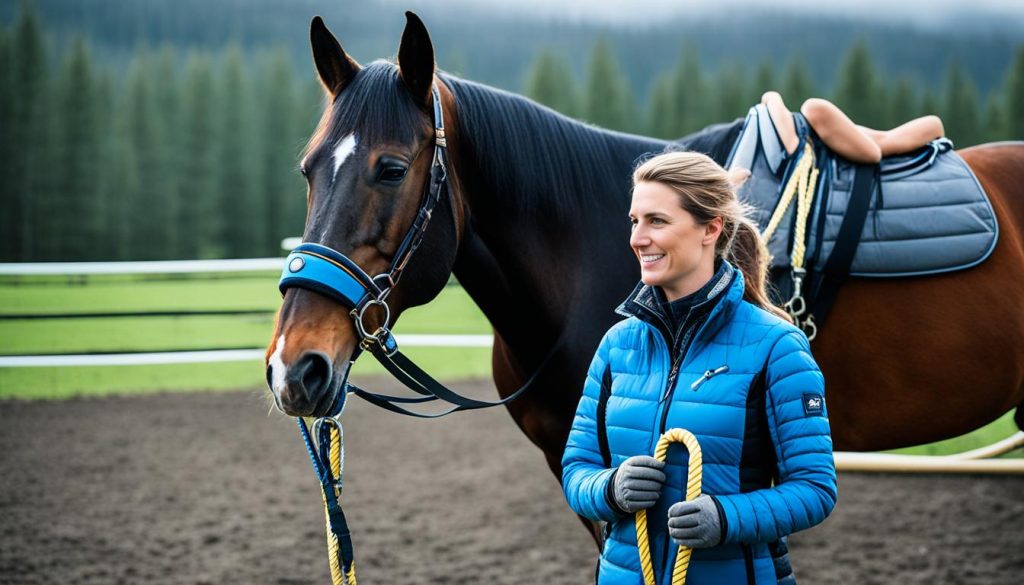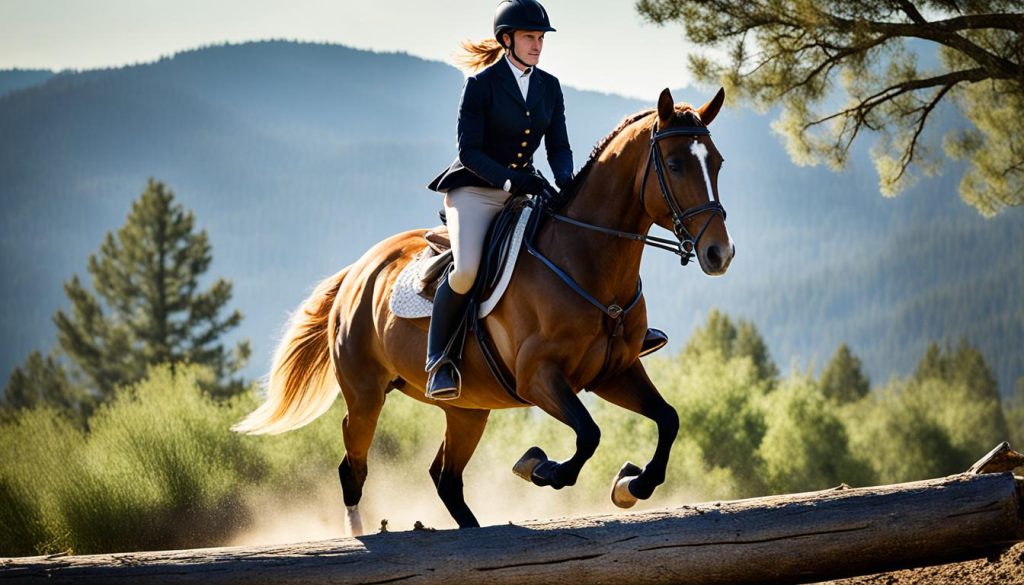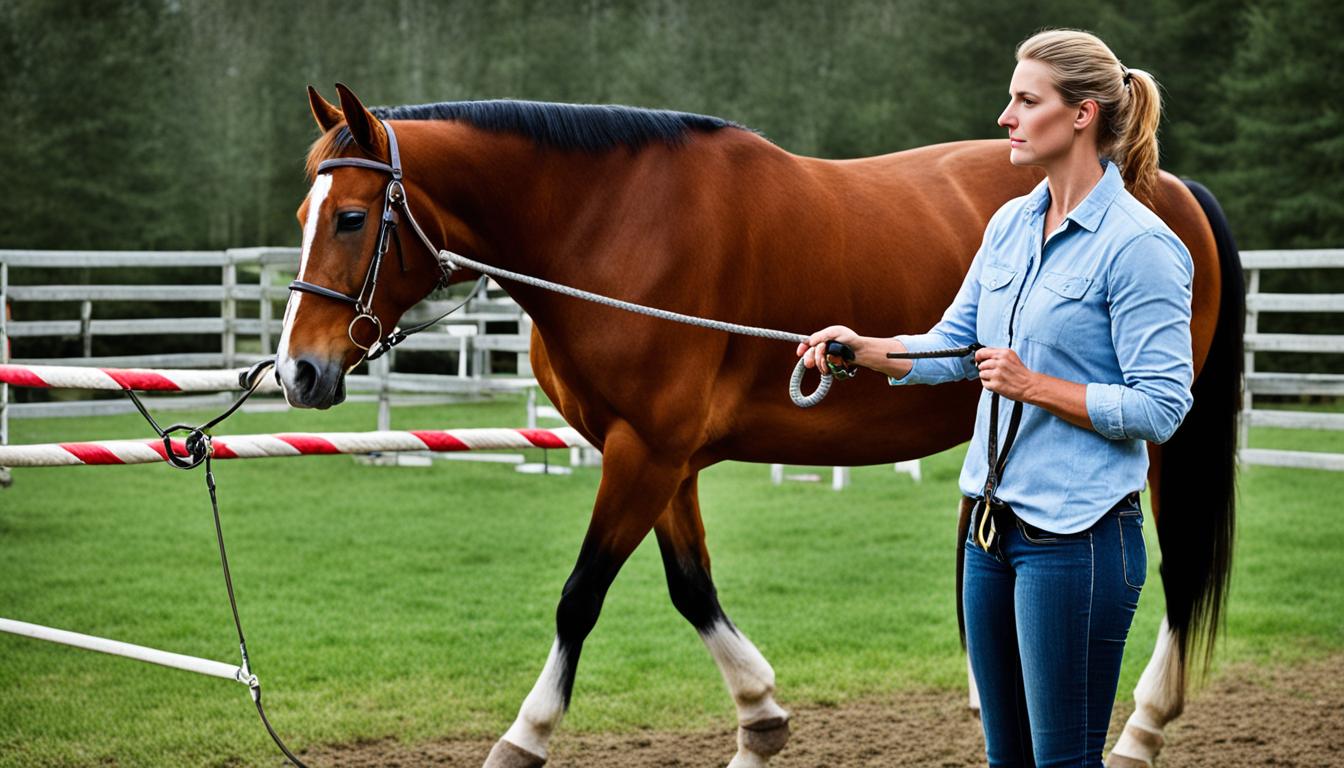“The essential joy of being with horses is that it brings us in contact with the rare elements of grace, beauty, spirit, and freedom.” – Sharon Ralls Lemon
Building a strong bond with your horse is not just about riding them; it’s about creating a relationship based on trust and respect. This connection is built from the ground up, through a series of important steps that lay the foundation for a harmonious partnership. Whether you are a seasoned equestrian or a beginner, these key steps will guide you in the process of establishing trust and respect with your horse.
Working Safely with Horses on the Ground
When working with horses on the ground, prioritizing working safely with horses is of utmost importance. Understanding your horse’s body language is crucial in anticipating their behavior and ensuring a safe environment. Here are some essential horse groundwork safety measures to follow:
1. Use Proper Equipment
Using a rope halter and lead rope provides better control and durability when working with your horse. These tools offer a secure grip and allow you to communicate with your horse effectively.
2. Wear Appropriate Footwear
Wearing closed-toe shoes or boots with a heel is essential to protect your feet when handling horses. The heels provide stability and reduce the risk of foot injuries.
3. Establish a Designated Training Area
Utilize a designated training area that is free from hazards such as sharp objects, loose wires, or uneven terrain. Ensure that the area is spacious enough for you and your horse to move comfortably.
4. Start with Simple Exercises
When beginning your groundwork session, start with simple exercises that both you and your horse are familiar with. This allows you to establish a connection and build trust gradually. It is crucial to be patient and give your horse time to understand and respond to your cues.
5. Be Prepared for the Unexpected
It’s important to remember that horses can be unpredictable. Always be prepared for unexpected reactions or behaviors and have a contingency plan in place. Stay alert and attentive to your horse’s reactions to ensure both your safety and theirs.
By following these safety measures, you can create a safe and productive training session when working with horses on the ground. Safety should always be the top priority to build a strong foundation of trust, respect, and communication with your equine partner.
Groundwork Exercises for Building Trust and Respect
Groundwork exercises play a vital role in establishing trust and respect with your horse. These exercises help create a solid foundation for a harmonious partnership. By incorporating a variety of exercises into your training routine, you can strengthen the bond between you and your horse while improving communication and understanding.
Leading Exercises
Leading exercises are fundamental for building trust and respect with your horse. When performing leading exercises, focus on walking calmly and confidently with your horse by your side. Maintain a relaxed yet assertive posture, radiating a sense of leadership. By practicing leading exercises regularly, you will establish a strong connection and lay the groundwork for effective communication.
Desensitization Exercises
Desensitization exercises help your horse become familiar with new and potentially intimidating objects or situations. Begin by introducing your horse to small, non-threatening objects, gradually increasing the complexity and intensity. This gradual exposure allows your horse to build confidence and overcome fear. Desensitization exercises promote trust, as your horse learns to trust your judgment and guidance.
Lunging Exercises
Lunging exercises are beneficial for improving your horse’s balance, rhythm, and relaxation. They also provide an opportunity to observe your horse’s movement and behavior from a distance. When lunging your horse, encourage him to move forward in a controlled manner while maintaining a steady and consistent pace. Lunging exercises enhance your horse’s physical and mental well-being, ultimately strengthening the bond between you.
Ground-tying Exercises
Ground-tying exercises teach your horse to stand calmly and patiently in one place. Start by asking your horse to stand quietly for short periods and gradually increase the duration. Ground-tying exercises help develop your horse’s self-control and patience, further reinforcing trust and respect.
Backing Exercises
Backing exercises are essential for building trust and coordination with your horse. By teaching your horse to back up in a controlled manner, you establish clear communication and create a rapport based on mutual understanding. Backing exercises also improve your horse’s maneuverability, making it easier to navigate challenging obstacles.
Obstacle Course Exercises
Obstacle course exercises are a fun and engaging way to build confidence, trust, and balance. By introducing your horse to various obstacles such as poles, cones, and bridges, you encourage problem-solving skills and enhance your horse’s adaptability. Obstacle course exercises strengthen the bond between you and your horse as you navigate challenges together.
Incorporating these leading exercises, desensitization exercises, lunging exercises, ground-tying exercises, backing exercises, and obstacle course exercises into your training routine will foster trust and respect with your horse. Remember, patience and consistency are key, and always prioritize safety for both you and your horse.

Enhancing Communication and Relationship
Effective communication is crucial for building trust and respect with your horse.
Yielding exercises play a vital role in teaching your horse to respond to pressure by moving their body away from it. This improves their coordination and responsiveness, strengthening your communication and bond.
By incorporating ground pole exercises into your training routine, you can enhance your horse’s balance, rhythm, and stride length. These exercises challenge their coordination and agility while fostering a deeper connection between you and your equine companion.
“I find that liberty work is an incredible way to establish trust and respect with my horses,” says equestrian expert, Jane Davis. “It allows them to express their natural instincts and enables me to communicate with them on a more profound level.”
When practicing in-hand exercises, it’s important to focus on precision and attention to detail while leading your horse. These exercises promote attentiveness and responsiveness, helping to strengthen your communication and reinforce the bond you share.
Introducing your horse to desensitization to sound exercises can greatly contribute to their overall confidence and relaxation in different environments. Gradually exposing them to various sounds helps them become more comfortable and secure, further deepening the trust you’ve established.

Building confidence over and under obstacles is another valuable exercise that fosters bravery and trust. This endeavor helps your horse overcome their natural hesitations and trepidations, allowing them to navigate challenging terrain with confidence, both on the ground and in the saddle.
Summary of Enhancing Communication and Relationship:
- Yielding exercises: Promotes responsiveness and coordination.
- Ground pole exercises: Improves balance, rhythm, and stride length.
- Liberty work: Establishes trust and respect through unrestricted communication.
- In-hand exercises: Enhances precision and attentiveness while leading your horse.
- Desensitization to sound exercises: Promote relaxation and confidence in different environments.
- Building confidence over and under obstacles: Fosters bravery and trust by challenging your horse’s hesitations.
| Exercise | Benefits |
|---|---|
| Yielding exercises | Promotes responsiveness and coordination |
| Ground pole exercises | Improves balance, rhythm, and stride length |
| Liberty work | Establishes trust and respect through unrestricted communication |
| In-hand exercises | Enhances precision and attentiveness while leading your horse |
| Desensitization to sound exercises | Promote relaxation and confidence in different environments |
| Building confidence over and under obstacles | Fosters bravery and trust by challenging your horse’s hesitations |
Conclusion
Building trust and respect with your horse is an ongoing journey that requires patience, consistency, and a deep understanding of equine communication. By prioritizing safety and implementing a variety of groundwork exercises, you can lay a solid foundation for building a strong bond with your horse.
Remember to always work at your horse’s pace and reward their good behavior. Building trust and respect is not achieved overnight, so be patient and understanding throughout the process. Engaging in fun and interactive training sessions will keep your horse motivated and eager to work with you.
Through effective communication and a commitment to developing a harmonious relationship, you can earn the respect of your horse. By earning this respect, you create a partnership that is built on trust and understanding. This partnership will lead to a rewarding and fulfilling journey with your equine companion.
Use these horse bonding tips to enhance the connection with your horse and deepen your mutual respect. Remember to always prioritize safety, engage in meaningful communication, and cherish the moments you spend together. Building trust and respect with your horse is a lifelong pursuit, but the rewards are immeasurable.
